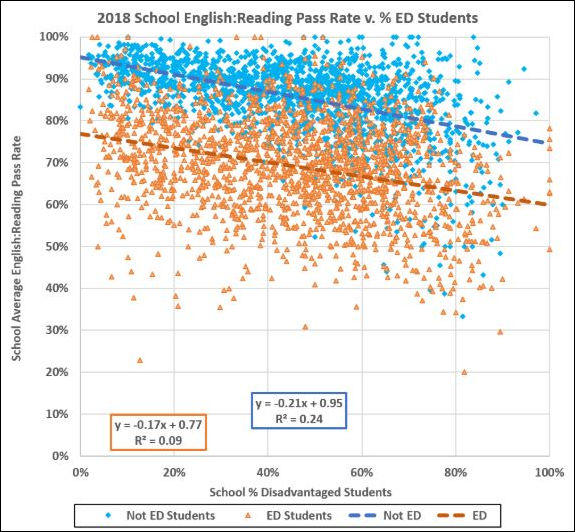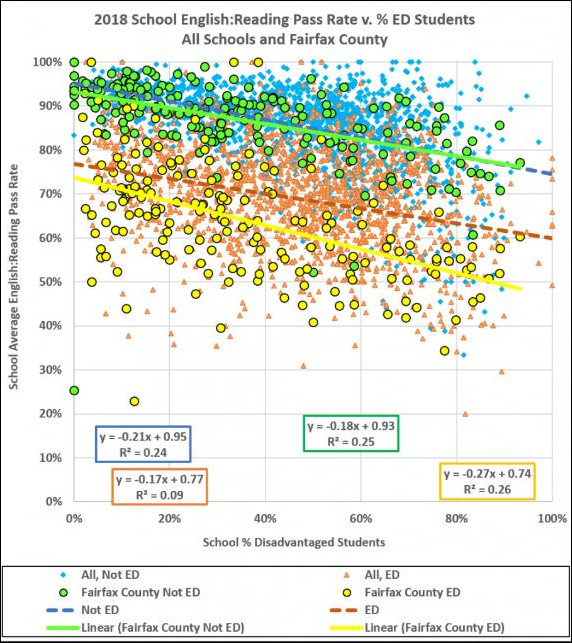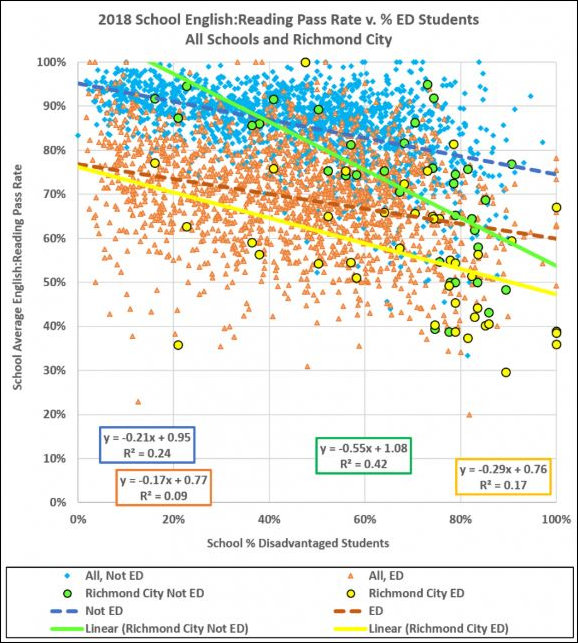Cranky, er, I mean John Butcher, continues to do the kind of statistical analysis of Virginia’s public schools that I wish we would see from our public officials. In a recent post on Cranky’s Blog, he dove deeper than ever into the relationship between economic disadvantage and SOL outcomes. And he demonstrated with greater clarity that some schools do better at educating disadvantaged students than others.
It is universally acknowledged that students classified as “disadvantaged” — qualifying for free school lunches — perform worse on average in Standards of Learning tests than do students not so categorized. Likewise, it is universally acknowledged that schools with higher percentages of disadvantaged students will tend to show lower SOL test scores than schools with fewer disadvantaged students, and that any evaluation of their effectiveness should take that fact into account. While the percentage of “disadvantaged” students accounts for roughly half the variability between schools, other factors — some of which schools and school districts can manage — also account for half.
In a graph published on Bacon’s Rebellion last week, John showed the variability between school districts. In the graph shown above, taken from his most recent post, he showed the correlation between English SOL pass rates and the percentage of disadvantaged for all schools. Then he did something particularly interesting — he overlaid schools from a specific district over the universal graph to show how that district compares to state averages.
The graph above compares average SOL scores for both advantaged and disadvantaged students statewide. It shows that the higher the percentage of disadvantaged students in a school, the worse both categories of students perform. In schools dominated by disadvantaged students, even the non-disadvantaged students do worse. Statewide, the depressive effect is roughly the same, as can be seen by the slope of the two lines.
Now, let’s look at some individual school districts.
In Fairfax County, Virginia’s largest school district, we can see that the effect of higher percentages of disadvantaged students upon non-disadvantaged students (the green line) is in line with statewide averages, but the impact on disadvantaged students (the yellow line) is particularly striking. What is going on? Do Fairfax School Board members have a clue that this is happening?
Now, looking at Richmond City Schools, we can see that the effect of larger concentrations of disadvantaged students has even more pronounced effects than in Fairfax County. The performance of disadvantaged students (the yellow line) drops off even more sharply than the state average. The performance of non-disadvantaged students (green line) drops off calamitously. No wonder parents from non-poor families yank their children out of Richmond Public Schools!
(John shows similarly sharply sloping lines for schools in the cities of Hampton and Newport News.)
This analysis leads to interesting lines of inquiry — lines of inquiry, it is safe to say, that few in the public school systems (and no one in the media) is asking. Why does academic achievement drop off so sharply for schools with especially high percentages of disadvantaged students? Clearly, the concentration of poor students has a deleterious effect. What is that effect? Different people will proffer different theories, depending upon their ideological persuasion. Readers should join me in urging John to probe even deeper.




Leave a Reply
You must be logged in to post a comment.